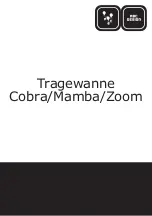
17
EXTERNAL INSPECTION
Weekly Inspection
1.
Perform a visual inspection on the valve and trim on a
weekly basis.
NOTE
: If the preaction system is equipped
with a low-pressure alarm, monthly inspections may be
sufficient. Consult with the local authority having jurisdic-
tion for specific requirements.
Monthly Inspection
1.
Record the system air pressure and water supply pres-
sure. Confirm that the water supply pressure is in the
range of normal pressures observed in the area. Signifi-
cant loss in water supply pressure could indicate an
adverse condition in the water supply. Confirm the proper
water-to-air ratio is being maintained.
2.
Confirm that there is no leakage from the intermediate
valve chamber. No water or air should flow from the drip
check.
3.
Check for mechanical damage or corrosion. If found,
replace any affected parts.
4.
Confirm that the preaction valve and trim are not sub-
ject to freezing temperatures.
5.
Verify that all valves are in their normal operating posi-
tions (refer to table below).
6.
If the system includes a Series 746 Dry Accelerator,
record the pressure in the accelerator’s air chamber. This
pressure should equal the system air pressure within the
allowable tolerances of the gauges. If the air chamber’s
pressure is below the system air pressure, follow the
“Troubleshooting” section on page 34.
REQUIRED TESTS
Main Drain Test
Perform the main drain test on a frequency required by
the current NFPA-25 code. The authority having jurisdic-
tion in your area may require that you perform these tests
on a more frequent basis. Verify these requirements by
contacting the authority having jurisdiction in the
affected area.
1.
Notify the authority having jurisdiction, remote station
alarm monitors, and those in the affected area that the
main drain test will be performed.
2.
Confirm that sufficient drainage is in place for a full-
flow drain test.
3.
Record the water supply pressure and system air pres-
sure.
4.
Verify that the valve’s intermediate chamber is dry. No
water should flow from the drip check.
5.
Verify that the system is pressurized at the proper air
pressure for the local water supply pressure.
Instructions continued on next page.
• Any activities that require taking the valve out of service may
eliminate the fire protection provided.
• Before servicing or testing the system, notify the authority having
jurisdiction.
• Consideration of a fire patrol should be given in the affected areas.
Failure to follow these instructions could result in serious personal
injury and/or property damage.
NOTICE
• The owner is responsible for maintaining the fire protection system in proper
operating condition.
• It is important that the system is inspected regularly, according to proper
procedures.
• The Victaulic Series 758 Preaction Valve and trim must not be exposed to foreign
material, corrosive environments, freezing conditions, contaminated water
supplies, or any other condition that could impair proper system operation.
• Modify the frequency of inspections in the presence of any environmental
conditions that could degrade system operation.
• The National Fire Protection Association pamphlet, which describes the care and
maintenance of sprinkler systems, outlines the minimum requirements for
inspections and tests.
• The authority having jurisdiction may have additional maintenance, inspection,
and test requirements.
Valve
Normal Operating
Position
Piston Charge Line Ball Valve
Open
Alarm Line Ball Valve
Open
Alarm Test Ball Valve
Closed
Alarm Drain Ball Valve
Closed
• Any activities that require taking the valve out of service may
eliminate the fire protection provided.
• Before servicing or testing the system, notify the authority having
jurisdiction.
• Consideration of a fire patrol should be given in the affected areas.
Failure to follow these instructions could result in serious personal
injury and/or property damage.
• Be careful not to open the system main drain valve accidentally.
Opening the system main drain valve will cause the valve to operate, resulting in
property damage.
DISCONTINUED
PRODUCT















































